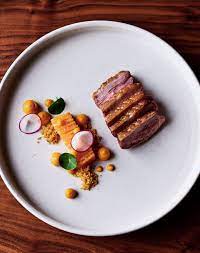How roasted prime rib can be prepared at home?
Method:
1. The roast should be salted and left to rest at room temperature:
Three hours before beginning to cook the beef roast, remove it from the refrigerator. It should be liberally salted before being lightly wrapped in butcher paper and left to sit. To promote more consistent cooking, roasted prime ribs should be brought nearly to room temperature before baking. Cut the bones away from the roast and tie them back on with kitchen string, if your butcher hasn't already done so. The roast will be considerably simpler to cut as a result.
2. Season the roast and preheat the oven:
Set your oven to 500°F. The roast should have released some moisture after being pre-salted, so pat it dry with paper towels before seasoning it with salt and pepper. Also, dry brine beef ribs that hasn't been cooked yet is in a roasting pan with salt and pepper.
3. Put the roast in a roasting pan fat-side up:
Make sure that the meat thermometer is not contacting any bones as you insert it into the thickest section of the roast.
4. To complete roasting, lower the oven temperature to 325°F:
To 325°F, lower the oven's temperature. Leave it for 12 to 13 minutes per pound for rare and 14 to 15 minutes per pound for medium rare when calculating the overall cooking time. Roast in the oven until the internal temperature reaches 130°F for medium, 115°F for rare, or 120° for medium rare. Once the roast reaches the desired temperature, remove it from the oven and set it on a carving board to rest. Before cutting, wrap it in foil and allow it to rest for 15 to 30 minutes. While the roast is resting, its internal temperature will continue to rise. Cut the cords holding the roast to the rack of dry brine beef rib bones before slicing it. Take out the bones.
5. Taking the finished prime rib's string off:
Taking the prime rib roast's bones out and then, cut the meat into serving-sized slices that are between 1/2 and 3/4 of an inch thick, cutting against the grain and dividing the prime rib into individual halves.
6. Create the gravy:
Take the roast out of the pan and then make the gravy. Remove any extra fat, leaving 1/4 cup of fat in the roasting pan together with the browned drippings and meat juices. Set the roasting pan over a medium-high flame on the stove. To remove any dripping that might be stuck to the pan, use a metal spatula. By utilizing a wire whisk, mix the flour and fat together. Allowing the flour to brown will give it more flavors and prevent your gravy from tasting like raw flour.
3 to 4 cups of water, milk, stock, or beer should be gradually added to the gravy. Stir regularly to break up any flour lumps as you continue to cook the food slowly.
It will take a while for the gravy to simmer and thicken, yielding around 2 cups. (Start with less fat and flour, then add less liquid if you want less gravy.)


Comments
Post a Comment